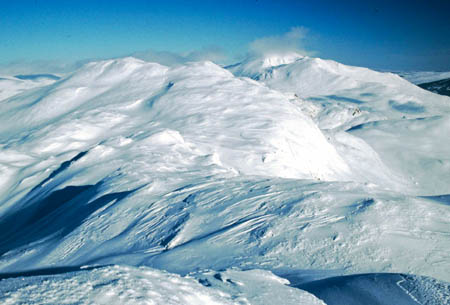
Ben Lawers under its snow blanket
While much of the country has moaned as it struggled to cope under Britain’s thickest and most prolonged blanket of snow for many years, climbers and walkers have been able to take advantage of the rare winter conditions on many of our hills and mountains.
And another, less obvious beneficiary of the increased amount of snow are is a rare mountain flower, which grows in only the harshest of conditions.
The Highland Saxifrage had disappeared from many mountains and a programme of reintroduction was started by National Trust for Scotland staff on the Ben Lawers national nature reserve. The trust said illegal plant collectors were partly to blame. There was just one example of the plant remaining on the 1,214m (3,984ft) munro before the trust staff set to work.
Now, all 12 reintroduced examples are thriving, along with six ‘offspring’. And the heavy snow seems to suit the rare plants, which are only found in about 20 mountain locations across Scotland.
Helen Cole, property manager and naturalist said: “The results reported last year – which are in part a measure of some of our work to conserve the alpine plants – were really satisfying. After all, Ben Lawers is one of Scotland’s richest habitats for plants of this type, and we are playing a key part in ensuring that it remains so, for generations to come.
“In recent years, snow cover in most mountain areas has become erratic and there is some evidence that this has led to population declines of some of our rarest plants.
“A few cold months are unlikely to make much difference in the long term, but it does give some hope that we may occasionally get the harsh weather that these beautiful rarities are supremely adapted to.”
Other beneficiaries of the harsh winter are the Rock Speedwell, a nationally rare arctic alpine that grows on cliffs and rock ledges from 500m to 1,000m above sea level, which had increased by more than 60 per cent in the past decade. A 2009 study found more than 750 plants. But another population showed signs that collecting is still going on.
Water vole numbers have also increases, possibly due to new fencing keeping large grazing animals away from streams, allowing an increase in vegetation for the animals.
Ecologist Dan Watson has recently joined the team on Ben Lawers. He was previously the trust’s property manager at Grey Mare’s Tail in Dumfries and Galloway. He will work both at Ben Lawers and Glencoe to develop long-term monitoring.
He said: “Both Ben Lawers and Glencoe hold nationally important populations of rare plant species, along with a great deal of other interesting wildlife. I am looking forward to getting out onto the hills to carry out the monitoring which is an essential tool for informing our conservation management.”
The Ben Lawers estate was bought by the National Trust for Scotland in 1950, thanks to the generosity of mountaineer Percy Unna, a president of the Scottish Mountaineering Club.
John
05 March 2010I do find it hard to believe and very sad that people who, presumably, go onto the mountains to enjoy the unique beauty will also take things from the mountains that add to that beauty. I am amazed that "mountain" people, who must surely respect the mountains will take these rare things that grow at altitude.